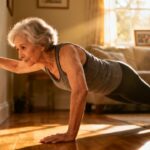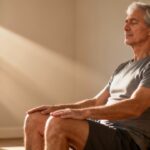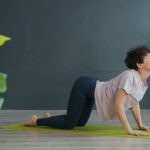You’re walking through your home, maybe carrying a cup of coffee when it hits you. You’re more focused on keeping your balance than enjoying the moment. Maybe you grip the chair as you pass. Maybe you hesitate before stepping off a curb. You’re not weak. You’re not clumsy, but something feels off.
Most people chalk this up to aging, but here’s a truth most don’t hear: You’re not losing balance because you’re getting older. You’re losing it because your brain, joints, and inner ear haven’t been asked to keep up. The problem isn’t wear and tear—it’s disconnection.
And that’s the exciting part because today we’re going to show you how to switch those systems back on. Not with hours at the gym or complicated routines, but with three deceptively simple movements that retrain your nervous system in just a few minutes a day.
Exercise 1: Heel Walks – Rebuilding Your Brain-Body Connection
At first glance, heel walks might seem almost silly—walking with your toes lifted off the ground, heels striking first, arms swinging gently at your sides. But don’t be fooled by how simple it looks. This is one of the most neurologically rich movements you can do after 50.
As we age, it’s not just our muscles that weaken. It’s our neural pathways—the brain-to-body signals that used to fire without us thinking. One of the most critical pathways for safe, confident walking is the one that tells your toes to lift just in time as your foot swings forward.
When this signal slows down or fades entirely, you start catching your toes on rugs, door frames, or uneven pavement. Trips become stumbles, stumbles become falls, and the brain, sensing danger, tells you to move less. It becomes a loop of fear and hesitation.
How to Perform Heel Walks
Stand tall, preferably near a wall or sturdy chair at first. Lift your toes off the ground, keeping your heels firmly planted. Begin walking slowly, one heel after the other, toes still raised. Let your arms swing naturally to help with balance. Take 10 to 15 steps forward, then turn around and repeat.
Don’t worry about looking odd. Your brain doesn’t care about appearances—it cares about reconnection. If you feel unstable, go slower. Focus on posture and breathing. You can start with as little as 20 seconds and build up.
Exercise 2: Side-to-Side Weight Shifts – Reclaiming Your Natural Balance
Most people think balance is about standing still, but real balance—the kind that prevents falls and builds lasting confidence—is about how smoothly you shift your weight when life pulls you in different directions.
Think about this: When was the last time you trained your body to move sideways? We walk forward. We climb stairs. We sit in straight-back chairs. Day after day, we move in predictable lines.
But in the real world, falls don’t happen in straight lines. They happen when you turn suddenly, step off a curb at an angle, or react to something unexpected. And when your body hasn’t practiced lateral movement, it doesn’t know how to catch itself.
How to Perform Side-to-Side Weight Shifts
Stand tall with your feet hip-width apart, arms relaxed at your sides. Gently shift your weight to your right foot without lifting the left. Feel the pressure increase on the right sole. Stay there for 2 to 3 seconds. Slowly return to center, then shift to the left. Repeat for 60 seconds, keeping your posture upright and your breath flowing.
Do not rush. Let the movement be smooth and intentional. This is not exercise—it’s awareness training. Each shift tells your brain, “This is what balance feels like.”
Exercise 3: Head Turns on One Leg – Training Your Inner GPS
Most people never think twice about turning their head until one day they do and the room spins or, worse, their body doesn’t keep up and they stumble. This isn’t weakness. It’s not just aging. It’s a system going quiet—your inner GPS, the vestibular system.
Balance is not just about muscles. It’s about how fast your brain receives, processes, and reacts to information about your position in space. Your eyes, your inner ears, and your joints all send data constantly. But when you stop turning your head, when life becomes still and predictable, your brain gets lazy.
How to Perform the Head Turn on One Leg
Stand next to a wall or chair for safety. Lift one foot and rest the toes lightly on the wall behind you for mental reference, not support. Soften the knee of the standing leg. Don’t lock it. Slowly turn your head left to right, keeping your shoulders still. Do this for 20 to 30 seconds. Then switch legs.
Start with eyes open and slow movement. As you gain confidence, try with eyes closed, but only when safe and steady. Avoid fast or jerky motions. The goal is gentle recalibration, not dizziness.
Practical Advice for Getting Started
You don’t need to master every movement on day one. Choose the exercise that feels most natural and make it part of your daily rhythm, like after brushing your teeth or during a TV commercial break. Use a wall or sturdy chair for support until your confidence grows.
Remember, consistency beats intensity. Even a few mindful minutes a day can create lasting change. If you ever feel dizzy or unsure, pause. Your safety comes first. Over time, your body will remember and begin to trust itself again.
You’re Not Declining—You’re Reconnecting
You’ve just learned three simple movements, but what you’ve really discovered is something far more powerful. Your body still listens. Even after years of sitting more than moving, even after moments of fear, hesitation, or self-doubt, your body still remembers how to balance, how to respond, how to protect you.
The beauty of this journey isn’t in perfection. It’s in participation. Because every heel walk, every side shift, every steady head turn is a message: I’m not done yet.
Balance is not just a physical skill. It’s a reflection of trust—trust between your brain, your body, and your environment. When that trust breaks down, fear takes over. But when you rebuild it step by step, you gain more than stability. You gain freedom.
Freedom to walk without overthinking. Freedom to turn quickly without panic. Freedom to move through life with confidence again.
So what now? Start with one exercise, just one today. Let your nervous system feel the spark. And if you’re ready to go deeper, do the full routine. It’s only 5 to 6 minutes, but done consistently, it can quite literally change how you walk through the world.








